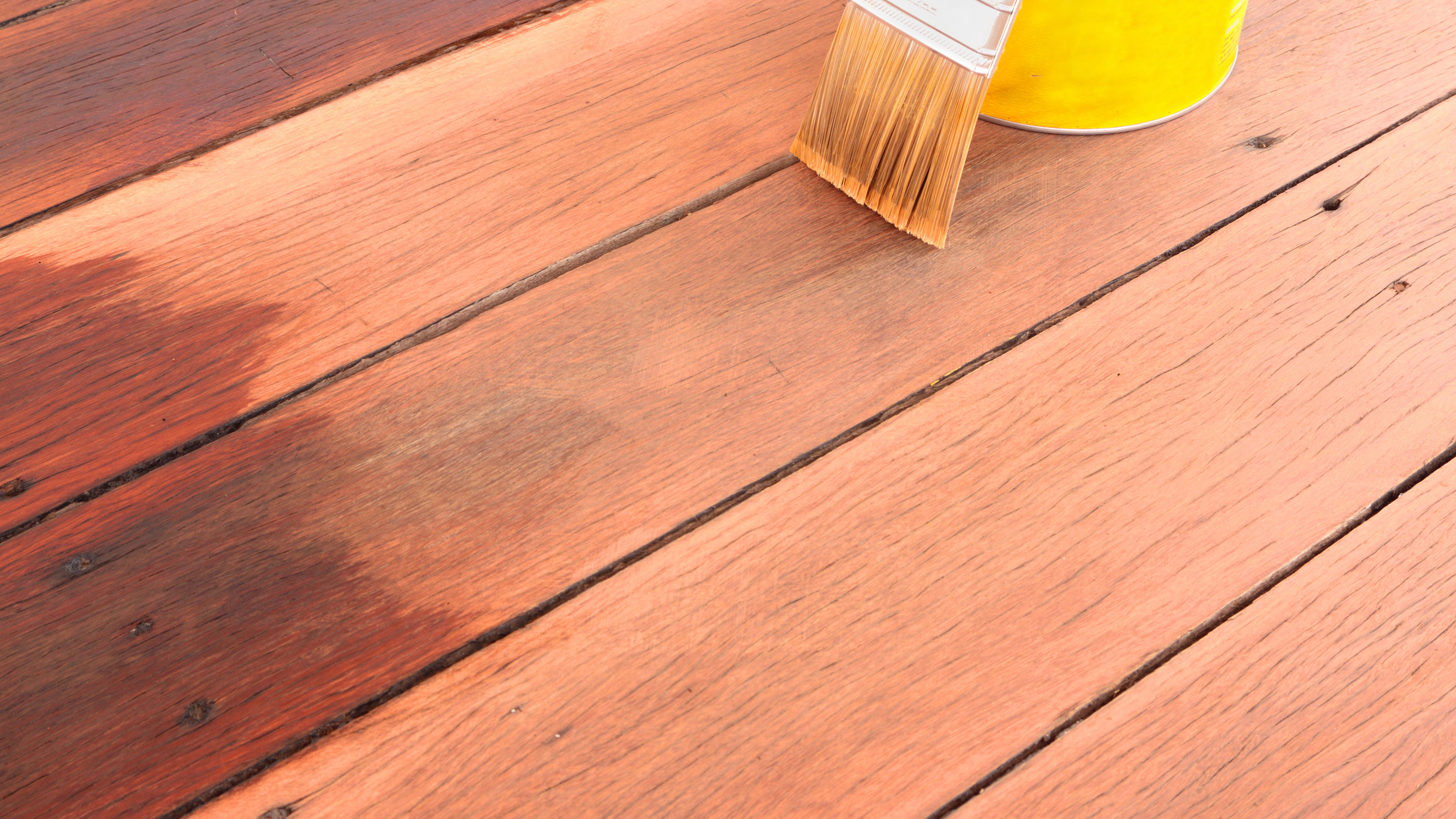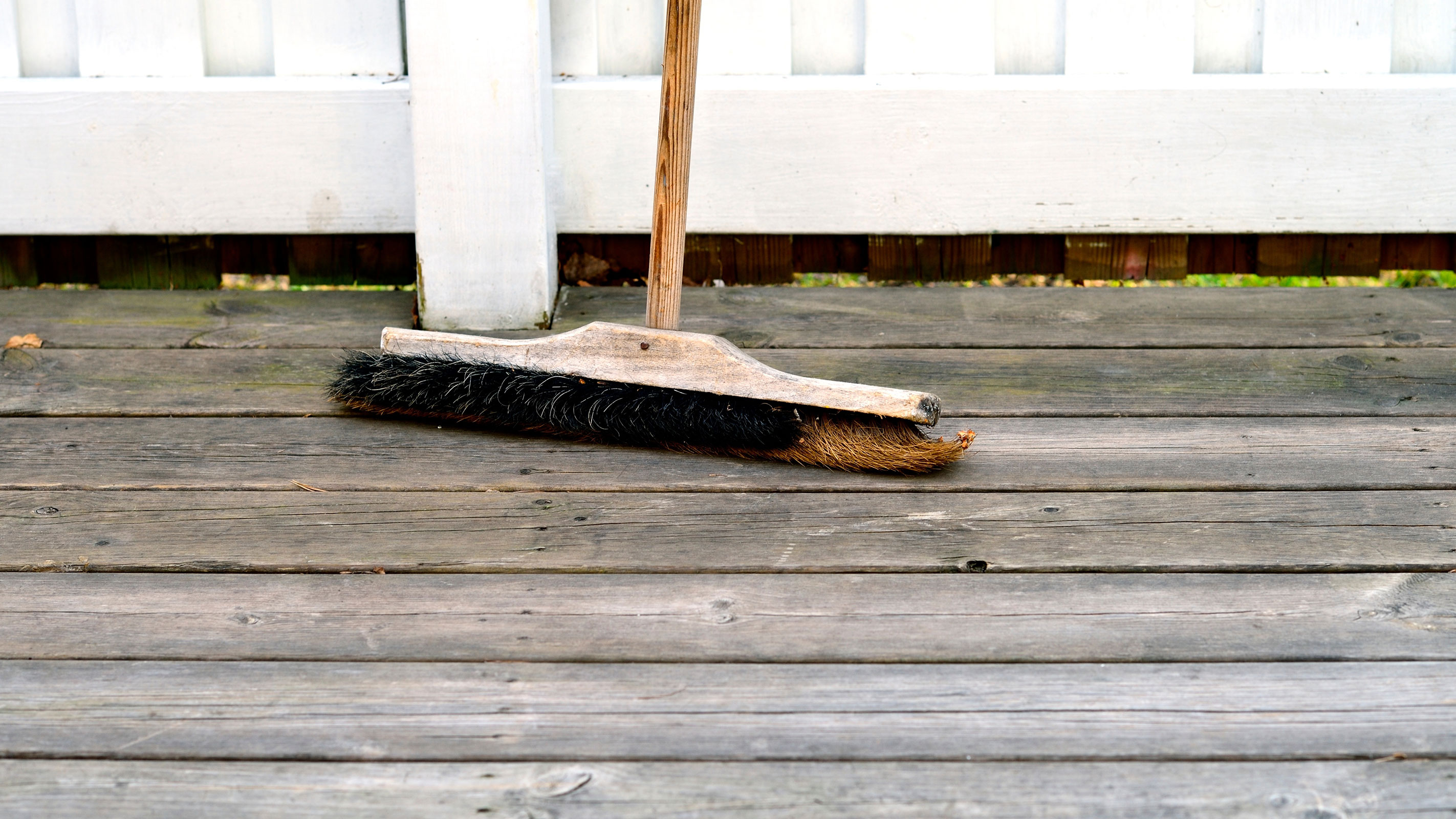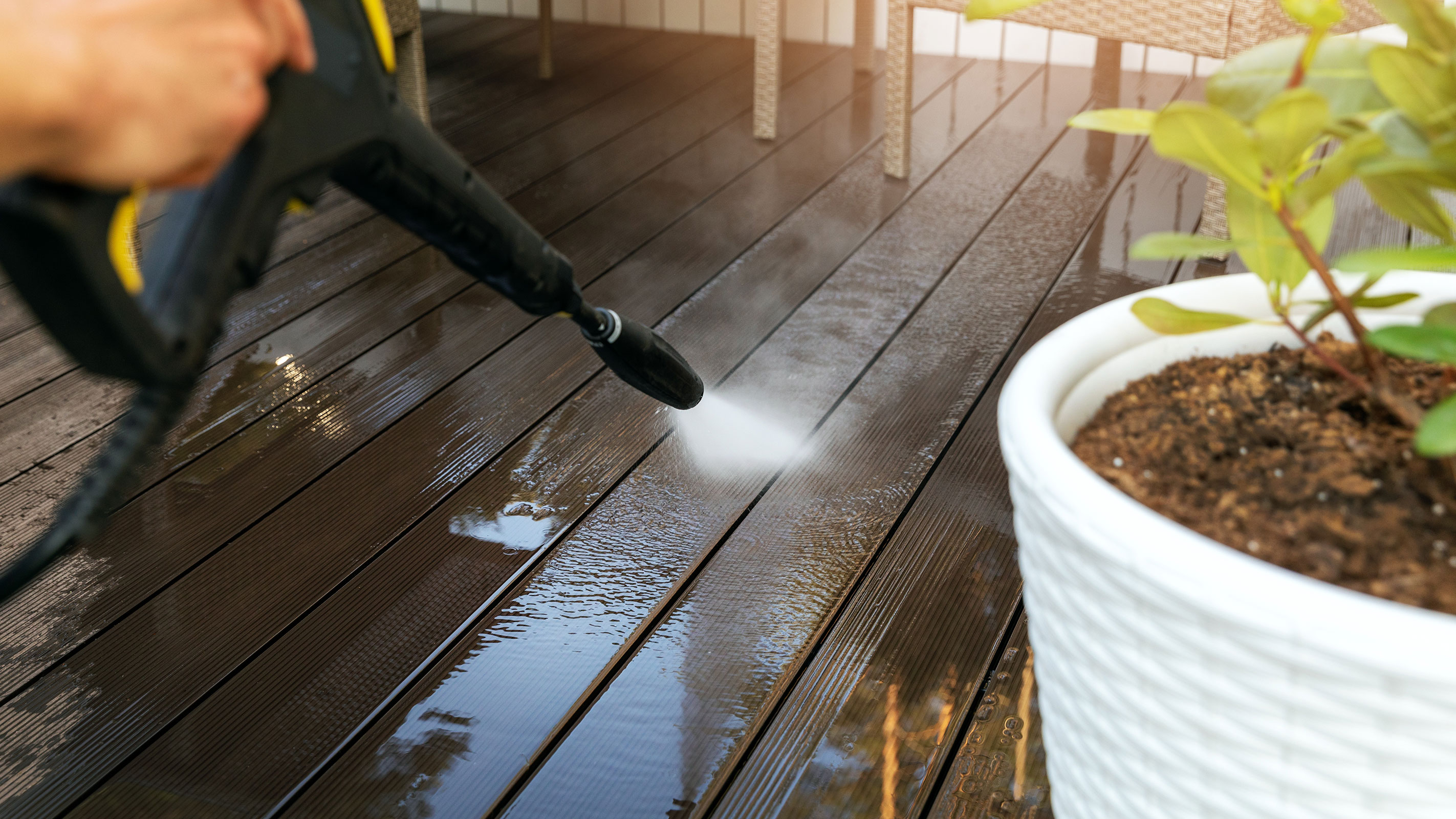Decking maintenance: 10 tips for looking after decking
Good decking maintenance is essential if you want your deck to keep its good looks for many years to come — plus it can prevent it from becoming slippery underfoot

Knowing what decking maintenance jobs to carry out and when to do them is key to ensuring that your carefully planned decking ideas are worthwhile.
Without the right upkeep, not only will the appearance of your decking suffer over time, but the materials themselves could also deteriorate far quicker than if you make the effort to give the deck a little TLC from time to time.
Here, we take a look at the tasks you should be carrying out to keep your decking looking great and performing brilliantly — both those that should be carried out frequently as well as those tasks that require doing only a couple of times a year.
Why is decking maintenance important?
How long does decking last? According to Ronseal, with the right care and maintenance you can expect timber decking to last for between 15 and 30 years — however, the better you look after it, the longer it will look great and perform well for you.
Common problems with decking include:
- Rotten deck posts and boards
- Cracked or split boards
- Warped or twisted boards
- Fading or discolouration
- Wobbly and unstable balustrade
- Slippery build-up of algae
- Dirt accumulation
Thankfully all of these can be prevented or remedied by regularly checking your deck over and carrying out maintenance and repair as and when it is needed — the worst thing you can do is leave it as the job will be much harder when you do finally get round to tackling it.
How often should I clean my decking?
Experts recommend checking over your decking on a weekly basis, looking out for damage, a build up of dirt and any other worrying signs.
Bring your dream home to life with expert advice, how to guides and design inspiration. Sign up for our newsletter and get two free tickets to a Homebuilding & Renovating Show near you.
While a weekly sweep is a great way to keep your deck problem-free, when it comes to cleaning it, there is usually no need to do this so frequently.
"As a rule of thumb, we recommend regularly cleaning your composite decking boards monthly with dishwashing liquid and water to retain the appearance of your decking and ensure its longevity," says Allan Jeffery, managing director at Ultra Decking.
When it comes to washing a timber deck, it is recommended that this be done once a year. Of course, this will depend on the weather conditions, the position of your deck and whether or not you have included any patio cover ideas over your decking space, which will go some way towards protecting it from the elements.
"Remember that the location of your decking can greatly affect the amount your decking needs cleaning," says Allan Jeffery. "For example, if you have lots of trees over your decking boards, this will lead to more debris on your decking surface that needs to be cleaned."

1. Regularly clean your decking
The number one job you should be carrying out to keep your decking in tip top condition is cleaning.
"Decking should be periodically cleaned from a safety perspective but also to help with longevity, as a build up of moss and lichen can cause it to become slippery and dangerous," says Leigh Barnes of Jacksons Fencing
"The main reason decking becomes slippery is the growth of mould and fungus," says Allan Jeffrey. "While these can’t naturally grow on composite decking, they do grow on fallen leaves, pollen, and debris."
Don't make the mistake of thinking that it is only timber decking that needs cleaning — composite decking will also require some care and attention.
"Cleaning your composite decking is essential in order to keep your decking looking beautiful all year round," says Allan Jeffery. "You must ensure that you clean your decking correctly so that you don’t damage the surface finish of the decking boards."
But how to clean decking? Ultra Decking suggest brushing composite decking before using a mix of ammonia-free soap and lukewarm water to lightly scrub the deck with a soft brush before thoroughly rinsing it off with your garden hose.
When it comes to cleaning timber decking, Leigh Barnes from Jacksons Fencing has some great advice.
"We recommend a gentle washing with slightly soapy water and sponge to remove dirt and cobwebs," says Leigh. "A very light abrasive such as a nylon kitchen scourer can be used along the grain. Do not rub against the grain as it is likely to leave marks."
2. Clean up spills straight away
If anything gets spilt on your decking be sure to deal with it straight away to avoid it turning into an ingrained stain.
"If you happen to spill grease, oil, or food on your composite decking, make sure to clean it right away," says Allan Jeffery. "The longer it takes for you to clean it, the more chance that the oils will soak into the composites, which will cause eventual damage to your decking."
This is also important in the case of timber decking, although should stains have soaked in you can always sand the timber back before refinishing it with your chosen decking oil or stain.
3. Refinish timber decking regularly
Timber decking can be oiled, stained or painted in order to prolong its life but don't assume that this is something that only needs to be carried out when laying decking — it should be performed periodically for the decking to stay in good condition.
According to tdca (Timber Decking and Cladding Association), sealers containing silicone or wax additives, designed to protect wood against water ingress, should be reapplied every year or so, while translucent stains should be refreshed every two to three years. Prefer the idea of painting decking? tdca suggest that solid stains and paints can be expected to last around five years and point out that they will need to be sanded or, in some cases, stripped before a new coat is applied.

4. Deal with rotten boards swiftly
If you notice that any of your decking boards, joists or posts are looking a little spongey or rotten, it is crucial that you don't leave the problem to get worse, otherwise all those initial decking costs you paid out could be wasted.
"If you notice a broken or rotting decking board, make sure to replace it immediately," says Allan Jeffery. "Not doing so can infect the surrounding boards. It also presents a safety risk if left untreated."
You should be on the look out for some tell-tale signs that signify there may be rotten areas, including visible rotting, soft and spongey areas, bubbling paint, crumbling sections of timber and holes in the wood.
If you catch the rot quickly, remove the rotten boards, joists or posts before treating the wood and replacing with new sections as required.
"It’s essential that you use timber that has been treated correctly for in-ground contact when building a deck," points out Leigh Barnes. "Decking posts and joists should be more heavily treated with a quality timber treatment, as these are going to be touching the ground and therefore more susceptible to rot and insect attack. The posts and joists that make up the foundations of the deck are integral to the longevity, as if even one post or joist fails, the integrity of the whole deck could be compromised."

5. Don't let water accumulate on your decking
It is really important not to let water pool on your decking, whether it is timber or composite decking ideas you have opted for.
"Composite decking is a water-resistant material, but this does not mean it won’t absorb moisture if fully submerged in water," says Allan Jeffery. "To properly care for your composite decking, avoid any build-up of water on the deck surface and ensure water drains off the deck easily."
After a lot of rainfall it is a good idea to sweep water off your deck using a stiff-bristled garden broom.
6. Regularly sweep your deck
This is a simple job requiring minimal effort yet it could make all the difference to the longevity of your decking.
Carrying out a weekly sweep of your deck to remove dirt, debris and fallen leaves will lessen the likelihood of of a build-up of moisture and bacteria — both of which can cause mould and rot to take hold. Not only will regularly sweeping your deck keep it in good condition, but it will also look better when cleaned.

7. Clean up throughly after a meal
If you intend on using your deck as somewhere to sit and enjoy an outdoor meal, it is really important that any food and drink spills are dealt with quickly. Not only will leaving food and sticky drink splashes attract all kinds of unwanted garden pests, such as wasps and rodents, but it could also cause damage to your decking.
"Homeowners using their decking as a cooking and dining area should always check for grease stains. If you notice an oil or grease stain on the decking surface, clean it immediately," says Allan Jeffery. "Remove the grease stain with vinegar and baking soda. Use the baking soda and vinegar mixture to gently scrub the affected area with a decking brush."
You could also use a specialist decking cleaner, such as Roxil 200 Wood & Patio Cleaner from Amazon.
8. Use pressure washers with caution
Although it might be tempting to break out the pressure washer to take the elbow grease out of cleaning your decking, this is not always the wisest route as even the best pressure washers could cause damage to both timber and composite decking.
"We only recommend using a pressure washer as a last resort when cleaning your composite decking," warns Allan Jeffery. "Although quick and convenient, pressure washing your decking can cause further damage to the deck’s surface when not used correctly or with caution.
"If you are using a pressure washer on your composite decking, ensure you don’t go too close to the deck surface, as this can distort the appearance of the boards. Additionally, you will need to make sure the setting of the pressure washer is low so as not to damage the decking boards."
In the case of timber decking, Leigh Barnes of Jacksons Fencing also recommends proceeding with care.
"A very light/distant cold water pressure washer can be used, but care must be taken not to damage the surface of the timber. The decking will lighten in colour when moss has effectively been removed."

9. Keep gaps in decking clear
Don't forget to clean out the gaps between decking boards as well as the boards themselves — particularly the expansion gaps that should have been left around the perimeter of the deck when it was installed (interestingly one of the most common decking mistakes people make is to overlook leaving these gaps.)
"If the gaps are clogged, it can hinder the water flow of the decking," explains Allan Jeffery of Ultra Decking. "A regular cleaning schedule should include the removal of dirt and debris in the spaces between the composite decking."
Brush dirt out from the gaps using a stiff bristled brush — an old toothbrush can be handy when it comes to particularly tricky areas.
10. Avoid using harsh chemicals when cleaning your deck
It is really important when maintaining your decking that you use the right tools and products for the job — some chemicals in certain cleaning products could affect the appearance of your timber or composite boards while others could actually damage it.
"Avoiding harsh chemicals such as bleach is imperative when maintaining your composite decking," says Allan Jeffery. "Bleach is a corrosive substance that will not only distort the colour and appearance of your boards but can weaken the structure and lead to structural failures, such as decking collapse.
"Additionally, bleach can be corrosive to metals, so not only will it distort your composite boards, but it can corrode the framing of your decking, leading to an expensive and time-consuming reinstallation and replacement process," continues Allan. "It is best to stick to warm soapy water when cleaning any stains you discover on your composite decking."
The same applies to timber decking, where a solution of slightly soapy water applied with a soft nylon kitchen scourer should do the trick.
Alternatively, use a deck cleaner recommended for the type of deck you have.
Natasha was Homebuilding & Renovating’s Associate Content Editor and was a member of the Homebuilding team for over two decades. In her role on Homebuilding & Renovating she imparted her knowledge on a wide range of renovation topics, from window condensation to renovating bathrooms, to removing walls and adding an extension. She continues to write for Homebuilding on these topics, and more. An experienced journalist and renovation expert, she also writes for a number of other homes titles, including Homes & Gardens and Ideal Homes. Over the years Natasha has renovated and carried out a side extension to a Victorian terrace. She is currently living in the rural Edwardian cottage she renovated and extended on a largely DIY basis, living on site for the duration of the project.

